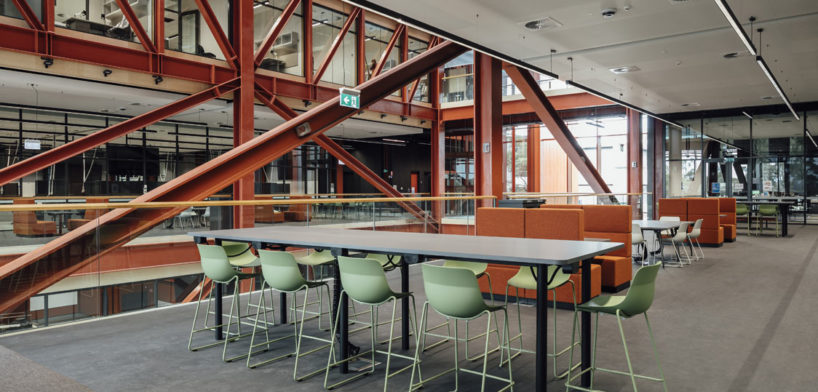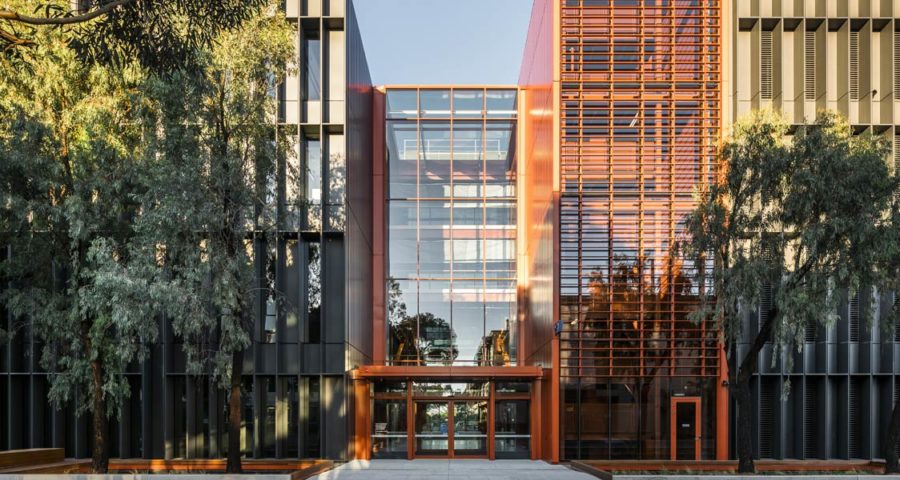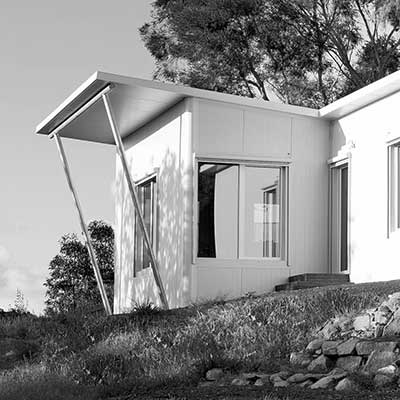 Interior image Building for Technology and Design; courtesy: aurecongroup.com
Interior image Building for Technology and Design; courtesy: aurecongroup.com Sustainable steel is something we at Superpod® believe in. Energy efficiency is something we believe in. Healthy indoor air is something we believe in.
But there’s a constant pull to think illogically about these things. We say, when you are looking at these issues, don’t throw the baby out with the bathwater!
Passive House buildings and temperature control
Sustainability is about energy efficiency. Despite the need to create energy-efficient buildings, building designs world-wide have failed. Our buildings suffer from ineffective strategies to reduce energy requirements. There is too much energy demanded by the buildings as they warm or cool the air for occupants’ comfort.
The International Passive House Standard deals with this. It provides an effective, science-based strategy to increase comfortable temperatures and significantly reduce energy demand.
Passive House buildings and clean air
Of course, another failure of our buildings world-wide has been ineffective ventilation, which is highlighted by Covid transmission issues. In a sense, the sustainability of a building should also speak to its health-giving qualities. Does it give health to the occupants? If not, we need to change the way we build.
Proper ventilation has suddenly taken on a new meaning. As Prof Morawska (Director, International Laboratory for Air Quality and Health (WHO CC for Air Quality and Health) wrote in July 2021: Australia must get serious about airborne infection.
The International Passive House Standard deals with this, too. It provides an effective, science-based strategy to increase healthy, toxin-free air to people living and working in buildings. Passive House buildings have mechanical ventilation systems which constantly extract stale and unhealthy air and constantly bring in fresh air, and can be filtered in all sorts of ways.
Passive House temperature control vs building materials
At Superpod® we have devised an energy efficient building system which can utilise a steel frame. We have patented this system world-wide.
Our system doesn’t have to use steel. We could use a timber frame.
But generally speaking, we take the view that steel has a place in our products and buildings, and that its use can be sustainable for a number of reasons. We also took the view from the very start that there are times that timber won’t work. It won’t be available, it won’t be suitable, it won’t be cost effective, and it won’t be sustainable.
Most people accept that steel is a necessary part of our world. Not just buildings, but cars, bridges, kitchen equipment, transport vehicles of all kinds, machinery, and surgical equipment all need steel.
Nobody would suggest using timber instead for most of these applications.
Anyone who has gone to China would be struck by the number, size and scale of high rise buildings made out of concrete. If China started building in timber the world’s forests would be denuded in about five minutes. For China, building out of concrete isn’t particularly sustainable, but timber is not an option.
We get it, people love timber. Its tactile, organic nature. It’s feeling of warmth. The backstory of the forest.
But if we really want to think about sustainability we have to be logical. We can’t just base decisions on emotion.

Monash University Passive House Case Studies
Interestingly, Monash University’s fabulous passive house projects are a case in point here.
First, they made a large building out of cross laminated timber. We have heard that the cost of this building was, well, not low.
Second, they made a large building using massive amounts of steel framing. Aurecon were the engineers, and Grimshaw were the architects. In a recent webinar, they said that they couldn’t get timber structural elements in Australia, they couldn’t get them in time, and that the carbon emission comparisons between using steel and timber came out even.
That was a ball park comparison done by the architects (not a detailed analysis), and there was no “sustainability” reason to choose timber over steel.
In fact, the second building, made out of a steel frame, is not dissimilar to the Superpod® concept. A steel frame, and an insulated sandwich panel to insulate the fabric of the building. (Of course the detailing is another issue entirely.)
So it’s clear from these comparisons that getting an energy-efficient building is about the Passive House 5 Keys: insulation and ventilation being two of them. Building materials is a secondary question. You can achieve the Passive House Standard in many different ways.
Global timber shortage
Timber isn’t always available in all places, as we have known for years. It isn’t always suitable, the effect of extracting timber from local forests is a crucial issue, and it isn’t always practical to get it.
Now there’s a global shortage, as well as an Australian shortage, and people are waiting many months to build their houses.
So what choices to people have? Wait for the ‘so-called-sustainable-at-all-times’ timber, or consider other options?
Steel is getting even more sustainable
As noted above, we think that steel has a place of its own in sustainable building production.
And the steel industry has been improving its steel production processes for many years. For example, recycled steel has become a greater feature of steel production.
More exciting developments are on the way. The New Yorker’s recent article: The Promise of Carbon-Neutral Steel explains how.
Passive House buildings and clean air in the Covid era
We have noticed some dialogue around the world to the effect that making buildings more airtight is a problem because it keeps the Covid virus inside the building and increases transmission between people. Ventilation strategies, as an afterthought for existing buildings, include the ground breaking advice to ‘open more windows’.
People need to go back to the Passive House Standard. It’s not just about making a building more sealed or airtight. It’s also crucial to consider proper ventilation at the same time that you design and build a building. Not as an afterthought.
That’s what the International Passive House Standard has always done. ‘Build tight, and ventilate right‘ is a familiar catchcry in passive house circles.
Don’t throw the baby out with the bathwater
We need solutions that are logical and wholistic. Solutions that consider all angles. Solutions that give alternatives.
Watch out for greenwashing in what you read!
When you are designing or building your next building, do consider the use of steel as a viable alternative to timber. If you want to consider the true carbon emission cost of using one material over another, do get a comprehensive independent analysis of the carbon emission effects for each building system you consider.
And do consider the use of the International Passive House Standard, with its wholistic, comprehensive approach. Seal up your building, and incorporate a proper ventilation strategy from the start and the right plumbing system. According to experts like an emergency plumber and drain cleaning service, these are the Plumbing Issues to Watch Out for in Cold Weather and learn how to make sure how to keep it safe and clean.





